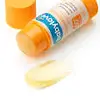What's inside
What's inside
 Key Ingredients
Key Ingredients

 Benefits
Benefits

 Concerns
Concerns

 Ingredients Side-by-side
Ingredients Side-by-side

Ricinus Communis Seed Oil
MaskingCaprylic/Capric Triglyceride
MaskingDiethylamino Hydroxybenzoyl Hexyl Benzoate
UV FilterCera Alba
EmollientEuphorbia Cerifera Cera
AstringentCopernicia Cerifera Cera
EmollientEthylhexyl Triazone
UV AbsorberBis-Ethylhexyloxyphenol Methoxyphenyl Triazine
Skin ConditioningHydrogenated Castor Oil
EmollientDicaprylyl Carbonate
EmollientButyrospermum Parkii Butter
Skin ConditioningSimmondsia Chinensis Seed Oil
EmollientAlcohol
AntimicrobialTocopherol
AntioxidantPentaerythrityl Tetra-Di-T-Butyl Hydroxyhydrocinnamate
AntioxidantAscorbyl Palmitate
AntioxidantAscorbic Acid
AntioxidantCitric Acid
BufferingGlycine Soja Oil
EmollientRicinus Communis Seed Oil, Caprylic/Capric Triglyceride, Diethylamino Hydroxybenzoyl Hexyl Benzoate, Cera Alba, Euphorbia Cerifera Cera, Copernicia Cerifera Cera, Ethylhexyl Triazone, Bis-Ethylhexyloxyphenol Methoxyphenyl Triazine, Hydrogenated Castor Oil, Dicaprylyl Carbonate, Butyrospermum Parkii Butter, Simmondsia Chinensis Seed Oil, Alcohol, Tocopherol, Pentaerythrityl Tetra-Di-T-Butyl Hydroxyhydrocinnamate, Ascorbyl Palmitate, Ascorbic Acid, Citric Acid, Glycine Soja Oil
Water
Skin ConditioningAlcohol
AntimicrobialDibutyl Adipate
EmollientDiethylamino Hydroxybenzoyl Hexyl Benzoate
UV FilterC12-15 Alkyl Benzoate
AntimicrobialGlycerin
HumectantEthylhexyl Salicylate
UV AbsorberDiethylhexyl Butamido Triazone
UV AbsorberPropylheptyl Caprylate
EmollientVp/Hexadecene Copolymer
Bis-Ethylhexyloxyphenol Methoxyphenyl Triazine
Skin ConditioningTriacontanyl Pvp
HumectantPhenylbenzimidazole Sulfonic Acid
UV AbsorberAcrylates Copolymer
Microcrystalline Cellulose
AbsorbentHydroxyacetophenone
AntioxidantTocopheryl Acetate
AntioxidantSodium Hydroxide
BufferingXanthan Gum
EmulsifyingCaprylyl Glycol
EmollientAcrylates/C10-30 Alkyl Acrylate Crosspolymer
Emulsion StabilisingGalactoarabinan
Ethylhexylglycerin
Skin ConditioningDisodium EDTA
Cellulose Gum
Emulsion StabilisingTocopherol
AntioxidantWater, Alcohol, Dibutyl Adipate, Diethylamino Hydroxybenzoyl Hexyl Benzoate, C12-15 Alkyl Benzoate, Glycerin, Ethylhexyl Salicylate, Diethylhexyl Butamido Triazone, Propylheptyl Caprylate, Vp/Hexadecene Copolymer, Bis-Ethylhexyloxyphenol Methoxyphenyl Triazine, Triacontanyl Pvp, Phenylbenzimidazole Sulfonic Acid, Acrylates Copolymer, Microcrystalline Cellulose, Hydroxyacetophenone, Tocopheryl Acetate, Sodium Hydroxide, Xanthan Gum, Caprylyl Glycol, Acrylates/C10-30 Alkyl Acrylate Crosspolymer, Galactoarabinan, Ethylhexylglycerin, Disodium EDTA, Cellulose Gum, Tocopherol
Ingredients Explained
These ingredients are found in both products.
Ingredients higher up in an ingredient list are typically present in a larger amount.
Alcohol comes in many different forms. Different types of alcohol will have different effects on skin. This ingredient is usually an astringent alcohol.
These alcohols are drying on the skin. They may strip away your skin's natural oils and even damage your skin barrier. Astringent alcohols may also irritate skin.
Other types of astringent alcohols include:
According to the National Rosacea Society based in the US, you should be mindful of products with these alcohols in the top half of ingredients.
Any type of sanitizing product will have high amounts of alcohol to help kill bacteria and viruses.
Fatty alcohols come from plant oils such as coconut oil. These can help hydrate the skin and are non-irritating. Some fatty alcohols include cetyl and stearyl alcohol.
Learn more about AlcoholYou might know this ingredient as Tinosorb S or Bemotrizinol. It is a UV filter that covers both UVA and UVB rays.
This ingredient has two peak UV absorption peaks ( 310 and 340 nm) and is able to absorb both UV-A and UV-B rays. This ingredient works by preventing UV rays from reaching and damaging your skin.
On top of that - it is highly photostable and helps prevent the photodegration of other sunscreen ingredients such as avobenzone.
Tinosorb S is allowed in the EU, Australia, and Asia. It is close to being approved by the FDA and we'll hopefully get this ingredient in the U.S. by late 2025.
Fun fact: Tinosorb S is the most effective UV absorber at maximum concentration (measured by SPF) permitted in the EU.
This ingredient is oil-soluble, so your oil-cleansers will take this right off at night.
Learn more about Bis-Ethylhexyloxyphenol Methoxyphenyl TriazineDiethylamino Hydroxybenzoyl Hexyl Benzoate (DHHB) is a chemical UV-A absorber. It is formulated for high UVA protection (320-400 nm).
DHHB is well-liked for:
DHHB has been approved by the EU, Japan, Taiwan, and South America for use up to 10%. Unfortunately, it has not been approved for use in the US or Canada due to slow regulatory processes.
This ingredient is soluble in oils, fats, and lipids.
Learn more about Diethylamino Hydroxybenzoyl Hexyl BenzoateTocopherol (also known as Vitamin E) is a common antioxidant used to help protect the skin from free-radicals and strengthen the skin barrier. It's also fat soluble - this means our skin is great at absorbing it.
Vitamin E also helps keep your natural skin lipids healthy. Your lipid skin barrier naturally consists of lipids, ceramides, and fatty acids. Vitamin E offers extra protection for your skin’s lipid barrier, keeping your skin healthy and nourished.
Another benefit is a bit of UV protection. Vitamin E helps reduce the damage caused by UVB rays. (It should not replace your sunscreen). Combining it with Vitamin C can decrease sunburned cells and hyperpigmentation after UV exposure.
You might have noticed Vitamin E + C often paired together. This is because it is great at stabilizing Vitamin C. Using the two together helps increase the effectiveness of both ingredients.
There are often claims that Vitamin E can reduce/prevent scarring, but these claims haven't been confirmed by scientific research.
Learn more about Tocopherol